~Somesh Kumar is an editorial designer and illustrator. This blog is where he tries to journal about his hobbies but often fails due to self-doubt and lack of sleep. ↓
Don't wanna be here? Send us removal request.
Text
Chapter 5, Away


Work on the last chapter has started, and I can tell at the very beginning that this chapter is going to be a pretty long one. So much to sum up before the book ends, and yet so little time to put it all together. One day at a time, little by little.
The above scenes are from the first time I left after school. Train journeys from Patna to Delhi are a mix of conversations about IIT aspirations, fate, karma, migration, politics, and morning walks. It's a game of Scrabble where conversations build up instead of words. You can play along or be a fly on the wall. I almost often chose the latter.
0 notes
Text
Goodbye, Green Virus
Nishant is dead. He hung himself and was found dead on 28th February 2025 at a hotel in Mumbai. He was going through a difficult period personally and financially, which led him to take this step.
I have made the details of his departure bare only to shift the focus away from his tragic end. Consider this as the door where we shut away his unkind recent past and now travel further back and meet him when he was with us at Srishti. A Nishant who was carefree, ridiculously funny most of the time, cunningly Kanpuria, and had a deep love for his work when he finally settled down at his desk.

Nishant sitting in the cafeteria at the Old Campus, Srishti, 2005

Nishant Tripathi (Green Virus), 2005
Image on the left: Nishant with his new watch on his first birthday at Srishti
Image on the right: Nishant donning a new look after a few months at Srishti
The batch of 2005 had just finished their orientation day at Old Campus, and a reserved, shy guy dressed in a faded green t-shirt and faded blue jeans quickly made his way out of college and walked back to the PG room. I could get a sense that he wasn't comfortable in gelling along with others, a shared feeling that I, too, felt because Srishti wasn't a familiar space when you had just landed there from a smaller city. Nishant wasn't my roommate, but I quickly smuggled him into being one because I felt a sense of belonging to him. What appeared to be a meek guy quickly turned out to be a wild card. He got his LML Freedom motorcycle sent from Kanpur, and when it landed at our house, the bullet hole stickers on it were clearly a statement of the rustic hinterland. My housemates, Nilotpal and Karan, felt at home soon enough with him. Govind and Girish, too, took kindly to him because Nishant was unpretentious and unapologetically rustic in his manners. His bike was soon used for multiple stunts and then taken to the fuel station, where he asked the staff to fill the tank for ten rupees! That's all the money he usually had on him, and he used it to his advantage well enough by pairing it with a forever-famished look on his face. There was a small provisions store close to our house where he once went to buy Maggi. He fished out five rupees with such a sorry face that the shopkeeper took pity on him and gave him a ten-rupee packet. With that Maggi, the Monday night RAW was a staple at House number 55. He loved Randy Orton and even attempted to try Randy's finishing move on dogs passing him by on the road.


On 15th August, 2005, Nishant and I went to a near by Quarry to take photographs

Over the next few months, Nishant's faded blue jeans got paired with a blue blanket that he wrapped himself up in while sleeping. In the middle of the night, sometimes a face would peek out of that blanket with a cigarette lit in his mouth and him sitting in a squatted position at the edge of the bed. He earned the name 'Tau Ji' for the very reason. If it wasn't the cigarette, then it was the quarter of Old Monk. It may seem like he was wiling away his time at Srishti, which most of the time he was, but he was passionate about animation and had a superb grasp of Flash software. The portfolio that got him into Srishti was based on his animated clips and the workings of Flash. At Srishti, he would then start to work on alternative assignments, which were largely about poking fun at the students and faculty with reimagined animated scenarios with impeccable voiceovers from Nilotpal and Govind. Those underground animations were a rage, and often, people would just show up to see how a reimagined version of Jyoti Sahi looked like in Nishant's world.

The boy was talented. He picked up the guitar like a fish takes to water. He would make ringtones on his Nokia 1100 by figuring out the sound of each key tone. When the first year came to an end, he had so many backlogs in assignments that the only way he could make it to the next year was by flexing his muscles on animation. For close to a week he worked like a dog. He wouldn't sleep, just a hunched figure wrapped in his blue blanket chugging at the project. His partner in crime was his equally famished looking desktop, but a marvel at doing things that no other system could. The CPU had the exposed aesthetic of a Kanpur slum, and the DVD burner was the crimelord of that province. It could run a DVD that has been scraped with sandpaper. He would lazily slam the CPU, and the DVD burner's door obeyed creakingly. Girish, Nishant and I often spent evenings playing Call of Duty, Unreal Tournament, and Half-life on that decaying machine. Ours was perhaps the first house in the SFS colony in Yelahanka to get an internet connection. We all pitched in for the bill, but in a few months we got to know that the bills were not getting paid, and only the Old Monk bottles were making appearances.
Consequences of actions were often an afterthought for him. While helping the seniors set up the Grad show exhibition at Alliance Francaise near Cunninghum Road, he took the wrong one-way route without a helmet. I was coyly sitting as the pillion rider. The motorcycle, a Yamaha Libero, belonged to our senior Nanju. The traffic cop directed Nishant to bring the bike to the side, which Nishant obediently did before revving the accelerator and escaping the clutches of the cop with my heart racing to drop out of my mouth.
We escaped. With Nishant, we all escaped the drudgery of life in those initial years at Srishti, but sadly, he couldn't continue escaping it. It's hard to come to terms that a guy who could even give a slip to the Grim Reaper chose to offer himself to death. Imagine him booking a room for himself, buying the equipment for his own end, slowly looking up at the ceiling and choosing that this is where it ends is as bleak as it gets. The only thing that interrupts this gloomy picture is imagining him sitting at the edge of the bed in the middle of the night, smoking a cigarette, a dim red glow on his face, and finding him in the company of friends who loved being with him. I would like to remember you that way, my foolish friend.
Goodbye, Nishant. Glad that we met.

The boys of Radhe Bhaiya Pan Bhandar featuring Nishant Tripathi as Tau Ji.
youtube
Watch this gem, too, while you are at it.
1 note
·
View note
Text

Wish I wasn’t posting this, but life can flip what you take for granted, leaving you like a pit of sadness that bubbles over now and then. Farewell, Teja. You were truly one of a kind.
0 notes
Text

Got the film roll developed, which was shot on Olympus MJU II. In one of the shots, I chose to ignore the camera's default flash setting and took the photo with the flash turned off. This particular one turned out to be my favourite one despite the lack of focus in it. The blurriness and the softness that came through gave it a dreamy look. The charm of shooting on film lies in such surprises.
Here are some more from that lot.


0 notes
Text
Connecting the Dots in Data

How do we design information so that it doesn’t overwhelm the reader?
FactorDaily’s latest story, ‘The Crying Shame of Image-Based Abuse’, went live this month. Written by Rohini Lakshané, who is a technologist, researcher and Wikimedian, the article gives an overall view of how Image-Based Sexual Abuse is prevalent in our society and the culture of shaming has made it convenient for women to be made easy targets.
I had been itching to work on a story backed by data so that I could try working on infographics and untangle complicated subjects into understandable chunks. I have often felt that when we work with data, we go astray from the insights and indulge too much in the stats. While data and graphs are essential and play a crucial role in analysis, as a reader, I believe the narrative and boiling down of insights are vital aspects that must be kept at the forefront when designing infographics. Rohini’s story had data, but it turned out that the journey mapping of how non-consensual images are captured and then floated out into the world of the internet before getting recycled again and again became the key visual piece for the story. The world of image-based sexual abuse runs deep, and having a core image that could map the perpetrators, their motives, and their modus operandi will help the reader get an overview of the subject.
The complicated part about the distribution of non-consensual images is that the source, destination, and intermediary are often interchangeable. My initial attempt was to address this, but it burdened one map to accommodate more information than it could manage. I wanted the graphics to be as low-tech as possible so that they could be adapted across different formats without compromising what it meant to do.

Breaking down the information into chunks for clarity

Sketching out the mapping of information for infographics
Creating three different infographics was a better way of disseminating the information. The first one was about mapping, where the capturing of non-consensual and consensual images takes place. The second focuses solely on the perpetrators, their motives, and what channels are used to distribute NCII (Non-Consensual Intimate Images). The last graphic focuses on how NCII gets posted and recycled in an incident. I will be discussing the latter one here in this post. I wanted the graphics not to be compromised by the screen size. Seeing beautiful infographics squished to illegible size on a handheld device is saddening. To counter this, I first worked for the smallest screen size, dictating the way the illustrations shaped up for the infographic. Since the illustrations had to work in small sizes, I kept the details minimal but gave them a slightly angular look to suggest the discomfort of the subject matter. The idea was to avoid creating stereotypical visuals, often putting the spotlight on women as victims. It was important to stay objective and look at the infographics to communicate subtle suggestions of the jarring reality the article discusses.


Sketching the visual language and creating the illustrations with a colour palette that has strong contrast
I first created a structure to tackle the flow of information. This stage is best done with neutral greys, so your emphasis is more on comprehensibility than stylisation. My initial attempt at stylising the graphic went overboard, and it started to create unnecessary interpretations, such as the Infographic looking like a tree. It’s essential to dial down and ask yourself what you want the reader to see and discard anything becoming baggage. I cut down the extra fluff, which helped me add further layers of information, such as how the NCII flows from one network to another on distribution channels. My partial colour blindness lends a particular brutality when I work with colour. Using colours in graphics is like using salt in cooking; it has to be just the right amount. I stayed away from dull colours because while the subject matter is not on the bright side, the visual needs to stand out when scrolling on a device, and secondly, the more colourful and noticeable range in the colour palette helps in the segregation of information.



A vertical flow of content for viewing the infographic on phone screen

Infographic for viewing on Desktop
I customised each of the graphics for three different screen sizes: desktop, tablet, and phone, but the reshaping of the content for the print output made it further enjoyable. Rohini was going to talk about IBSA at the Asia Pacific Feminist Forum and wanted to take a set of flyers for it. Working with print is often exciting because the format can be extremely playful, and you get to capture the audience’s attention in a focused manner because this is not Instagram or a Chrome tab that you can switch to. I tried to work with folds of paper based on the lead illustration for the story. The illustration attempts to put the reader into the shoes of the perpetrator, who is trying to look at a woman changing her clothes. When you unfold the paper, the undressed parts are revealed. The act of this is meant to spotlight the perpetrator first, and then you get the overview of the story through different graphics and tables highlighting the critical parts of the story.



Flat view of the flyer when unfolded
A well-designed output is like a competent driver getting a good engine, and we need more thoughtful design in the societal work to take the conversation further.
Reposted from FactorDaily's Medium page.
1 note
·
View note
Text
हम मशगूल थे अपने ग़म के ग़मी से,
नज़रें उठायी तो मंज़र देख शर्म सी आ गई।
—
खुफिया कातिल
0 notes
Text

Thank you, Poonam, for bringing rigour to the field of design education, and a sense of purpose to design practice. Feel blessed to have you as teacher in the initial stages of my design education. I have clear memory of sitting in the New Campus with Andy (Anirudh Dube) sharing the table. We were told to draw straight lines freehand. Andy and I were figuring out how to do this right. Should we move our hands slow or fast on the paper? For someone who came from a very traditional rote based education, this made sense as much as what wasn’t making sense in a place like Srishti. I thought I was skilled, and then Poonam tore my drawing sheets saying how my lines were not straight enough. Thank you for that, Poonam. Thank you for shattering the ego because as a designer we are often full of it. I have immense respect for your zeal towards design practice.
You are forever in my memory. Thank you for making me learn and unlearn.
0 notes
Text

Don’t get time to sit and indulge myself in drawing the ideas that pop into my head, but today I took an hour away to make this quickly.
Election season is here and the BJP lovers are claiming their blind love.
2 notes
·
View notes
Text
Olympus SP 35
My constant lookout for a handy size camera with manual controls has been a never ending one. Earlier this year, the question for such a camera brought me to Olympus SP 35. A slightly battered piece of this camera was stocked at Mr Prabhu’s store. I fell in love with it as soon as my hands rested on it. Compact in size, good wide aperture, manual controls for aperture and shutter speed. It’s a rangefinder, and I am still not confident of getting the focus right at all times. On top of that the light meter was not working on it, so it left me in some doubt, but I brushed it aside and picked it up anyway. Mr Prabhu told me about the Sunny 16 rule for shooting without a light meter. On a sunny day, when shooting out in the sun, you keep the aperture at 16 and shutter speed a fraction of the ISO. I had an Ilford 400 film, so I decided to shoot on 1/500 with aperture set on 16. From there on I shot the entire film with calculated guess work. Adjusting the aperture is far more straightforward, but lowering the shutter speed requires more careful adjustments.


The results came last month, and I am pretty happy with my work on shooting without a light meter. The roll in places had misbehaved in winding, so some shots have come only half-exposed. A pity because it ate up one good shot of Sufi. Lately the Ilfrod 400 films are not giving results the way it used to. Too much grain in many of the shots. Hoping for better results in the few remaining rolls from my Ilford stock.
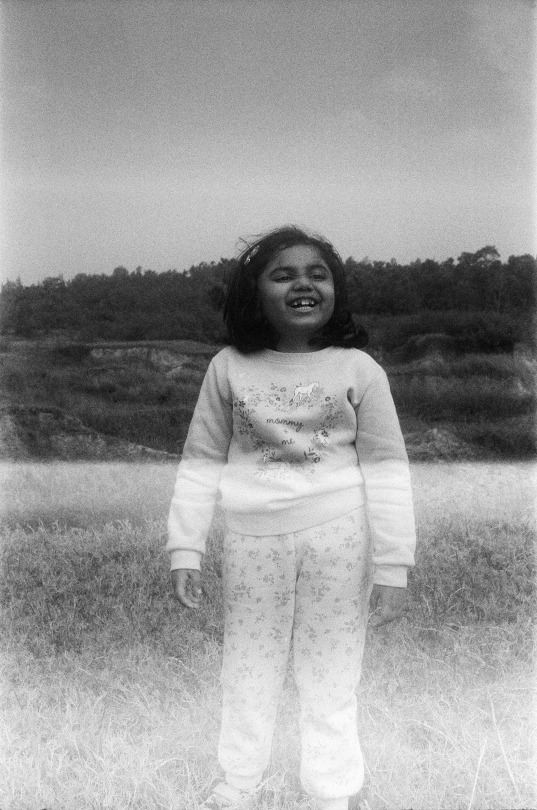
Sufi at Sakleshpur.


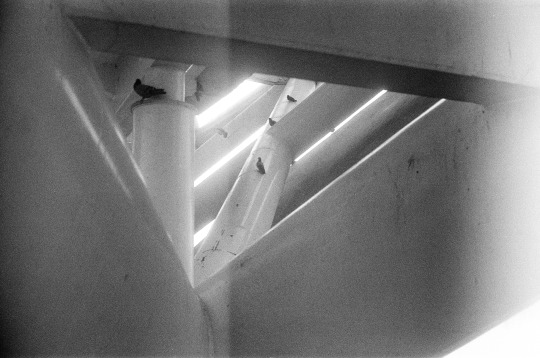

Shots of Atal Path, Riverfront, Ahmedabad.




Shots from Paldi, Ahmedabad.
You can see the rest of the shots on my Flickr page.
#shootingon film#filmphotography#analogue photography#blackandwhitephotography#photography#olympussp35
1 note
·
View note
Text
Turning 37
I turned 37 few days back and Sufi gave me the loveliest gift in the form of a set of cards (picture book, graphic novel). Call it whatever, but it was such an adorable thing to get from your child. Sufi had been working on it for more than a week, trying to hide it from me as much as possible, but also letting me bind the pages. I did so pretending that I haven’t seen what the pages contain. Nidhi has done the art direction, and I can see all the love Sufi has put into it. It’s such a warm, fuzzy feeling to get such unadulterated love from your child. Love her to bits.





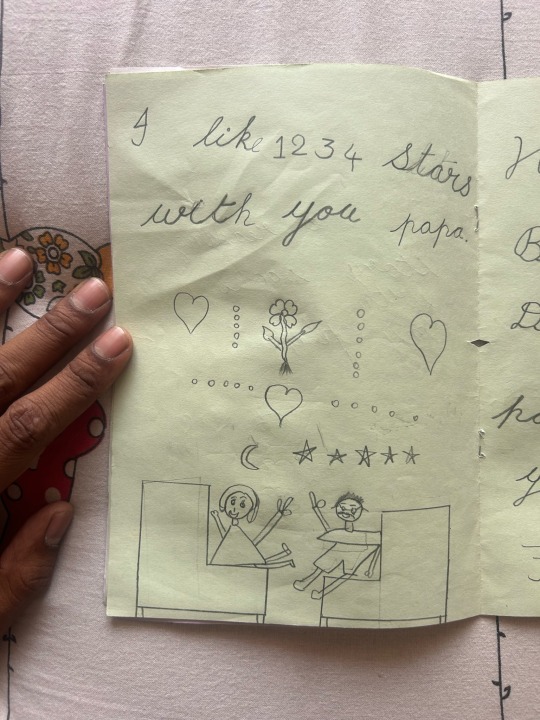
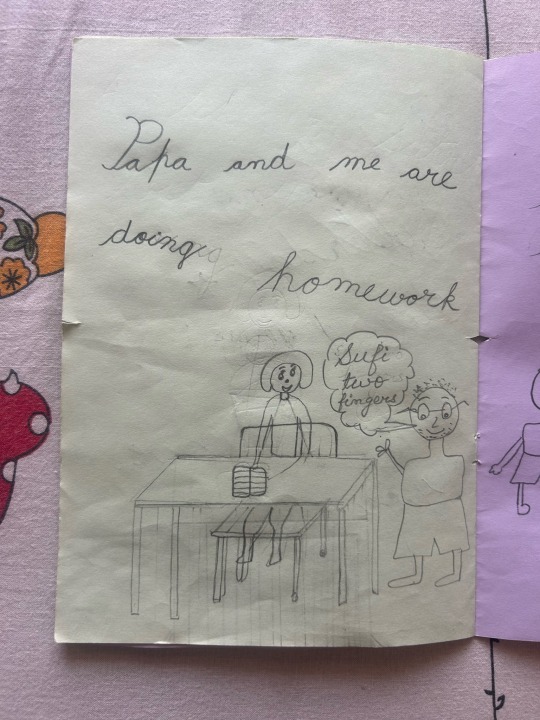
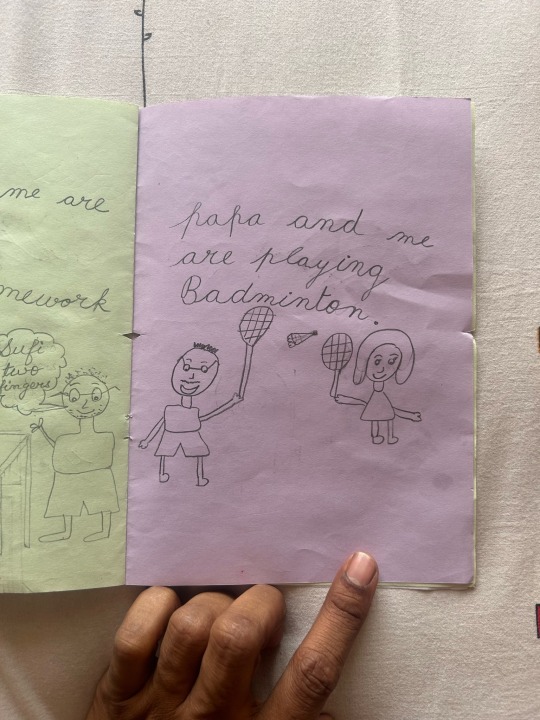


4 notes
·
View notes
Text
Why do we need to be so consistent all the time?
It just occurred to me one recent Monday that I have been quite hard on myself, demanding that I perform every single day with the same consistency. I felt this way more after returning home from taking a course for almost two weeks. Being away from home feels tough because I miss Sufi, and while it’s nice to come back home, it also brings a barrage of things on my to-do list that I need to tend to. I love making lists. It helps me organise my day and to know what has to be looked into in the near and distant future too. While it’s good to have lists, it also repeatedly nails down the fact that there is so much to do every day. The enormity of lists can be a crippling factor to my own efficiency when it’s staring me back so closely. But then one day a switch turned and a voice erupted within my head asking why I am trying to be consistent every single day. When our days are not the same because of the so many uncertainties revolving around it, then why must be ticking all the boxes too. I remember last year around this time Chelsea was struggling massively to play up to everyone’s expectations. Chelsea, a Club that has had a winning legacy in the last couple of decades has had a downward fortune lately. Change of ownership, staff, manager (nothing new about that), and players leaving had removed the core structure of the club. Then the long injuries of many players didn’t help the cause much. With all this going on one would ideally temper down their expectations, but the narrative I saw from football pundits always went on the same tune of how winners find a way to perform no matter what. While it’s commendable for people and teams to do well even with ongoing adversities, why does it have to be made a yardstick to beat everyone else with it? I had been doing the same to myself. I am not a guy in my 20s-30s anymore who could just roll out of bed each morning and start working with nothing else to attend to. My list of responsibilities has increased too with my age, and that’s a normal thing because this is what adulthood means. I had been still looking at my work efficiency model from a younger version of myself, and I won’t be able to match up to that age and effort because I just don’t have that kind of time anymore. I am trying to understand that I have to allow myself to be okay with things slipping away from my hand. I won’t be able to show up for each and everything to the best of my abilities because I should allowed to be inconsistent. I had read a quote by Ed Smith that every good process needs an anti-process. Similarly, to be consistent, you need to be inconsistent too. But it’s also the social media trap that has made this idea of consistency a painful reminder. The experts keep going on about how on social media you need to be consistent to get traffic. You need to post every single day, you need to be consistent with your tone. Maybe for a business that makes sense, but as an individual, we have good days and bad days. On good days, I am happy to share and interact, on bad days I need solitude. This made social media a difficult space to navigate with my earlier inert demand for consistency. Self-improvement is a trap, and we should be allowed for our inadequacies as much as for our abilities. I tried too hard to understand why we need validation because social media depended so heavily on it. It does feel good to me when I something I share resonates with someone. Seeking validation is not always a sign of downright narcissism. There is the negotiating space of balance. You tow this line of getting validation carefully. Maybe don’t deny validation vehemently, and definitely not gorge on it.
2 notes
·
View notes
Text
Illustration at NID
To start things off this year with teaching, I had a ten and half day course at NID with the Animation, Masters students. I taught them illustration as departmental elective. Somewhere my illustration course and basic graphics course tend to have a very similar objective; how to come up with visuals that are intelligent, have a conscious understanding of the creator’s gaze at the subject, and what are the alternative ways of representing a subject instead of a direct and bland approach. Illustration like design borrows a lot from the problem finding approach. There are contexts and constraints that guide your decision, and the limitations itself bring out the fun and challenging aspect.
The batch I taught was quite small; six students regularly seen in the classroom, and I was happy to have such a tight manageable bunch who were open to looking at illustration more than just drawing. Thank you for putting up with all the cutting and pasting. It was delightful to spend the time with this dedicated bunch.
1 note
·
View note
Text

I finally finished the literally long-drawn school intro part from the Patna chapter. Last year was not a very good one for the novel. The work was slow, often barely moving, burning a hole inside me. I planned for dedicated time towards the end of the year, but like most things in life, it didn’t go as planned, and some of the blame is on me, or my lack of being driven towards my book. The time I could find a few years back has become elusive, and some of it is down to the rising expenses, and being more available at home. I have made peace with the fact that this work will take time. I may not be able to find dedicated pockets of time to get a lot of work done. In fact on most days, finding dedicated time to work in itself has been a challenge. Making elaborate plans also hasn’t been of much help on this. The idea is to work on it as and when I can. It’s like making a kite fly, you have to know when to tug and when to let the string go. As long as the kite is afloat in the air, it will also keep my spirits afloat. Hopefully one day it will get where it has to be.
1 note
·
View note
Text
Nikon F50 and an ode to Girish
Early this year, I got Nikon F50 as a spare camera body to use it as parts for my NikonF80. The F50 was in a bit of rundown condition, and its shutter wasn’t releasing. The display kept showing errors, and once I put a lens on it, the error was resolved, but it was still not a functioning unit. I opened the back of the camera and tried cleaning the shutter leaf with a brush. I kept at it, hoping that it would help in getting the parts moving. To my surprise, it did the trick and the sweet sound of a film camera’s shutter releasing with the film advancing sound soothed my ear. I was overjoyed to have brought a camera back to life. After a few months, I finally loaded it with Arista 200 film. I had never used this film before, and I was hesitant to use a lford film on a new camera body. The results came back today, and I was pleased with a few shots, but most of the shots didn’t have a good contrast, and there was a lot of shake in shots that should have ideally been crisp. Not sure if it was because of the camera, but I was pretty certain that I would have got these right on my Nikon F80.
I am glad to have got two shots of Girish somewhat right. As a person with a camera, the only way to shoot people well is when they feel comfortable with the camera being pointed at them. I can’t say that I have made Girish comfortable, it’s more of a resignation at his end. I don’t have a lot of photos of Girish. In this day and age where our phones are flooded with photos with facial recognition categorising them conveniently, I barely have a few photographs of a friend who is very close and holds importance in my life.
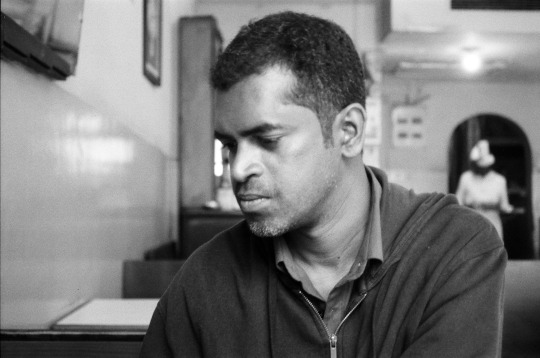

Girish was one of the first people I interacted with when I joined college. Even before I had landed there, Girish had written me an email asking if I would like to share the PG room together. It didn’t materialise in the beginning, but in a few months, Girish became our housemate. The early years of my college were when I was finding my feet in a world that was drastically very different from the world I had come from. Srishti was an antithesis of whatever I had known and understood the world to be. Girish helped me anchor myself focus on what mattered, and do so without any gloss or high-headedness. Girish lived like a monk. He owned what was needed, and did things that had a sense of delayed meditativeness. Whether it was his Adobe Illustrator files or his neatly two-columned handwritten journals, there was a mindful frugalness to his existence. He inspired me to the extent that I copied him. And the societal sense of my relationship with work is largely attributed to him. I still wish I could be more like him. Girish has no social media existence. We talk on the phone or meet in person more than we exchange texts. His emails are hearty and flow like he is speaking with you as if you are there on the other side of the screen. The saplings that grew on the side of his terrace were replanted at a farm outside of Bangalore because he chose to care deeply. To do things that you love, without a care for who is going to see it or react to it, is a sense that I would like to have towards the time I have. Because social media can be a trap. You shared what you loved, and now you love because you have to share it, or you are more busy sharing it than loving it.
I am not Girish, but I can say that there is always going to be a lasting influence of him on my life. Thankful for it.
1 note
·
View note
Text
क्या मैं हताश हूँ?
शायद परास्त हूँ।
नहीं धूल सिर्फ़ जमी है,
उसे अभी चाटा नहीं है।
दिन दिन के कामों से
अपना कुछ चुराता हूँ।
फिर भी रात को थक कर
यह सोच के सो जाता हूँ
कि समय निकाल पाऊँगा
मशक़्क़त के
फ़ुरसत के।
फ़िलहाल तो बस झांकता हूँ
एक कुएँ में
जहां रोशनी झांकती नहीं
इस पहर को।
पर दोपहर बाक़ी है।
आज की नहीं
तो परसों की ही सही।
-
ख़ुफ़िया कातिल
0 notes
Text
सड़कें ऐसी ऊँची हुई,
कि दरवाजें घर के डूब गये
खिड़कियों से क्या देखोगे,
ये क़स्बे कब के छूट गये।
_
ख़ुफ़िया कातिल
2 notes
·
View notes
Text
यूँ तो मैं मकान नहीं ढूँढता
लेकिन लोगों ने इतना पता पूँछा
कि जवाब ख़रीदना पड़ गया।
_
ख़ुफ़िया कातिल
0 notes